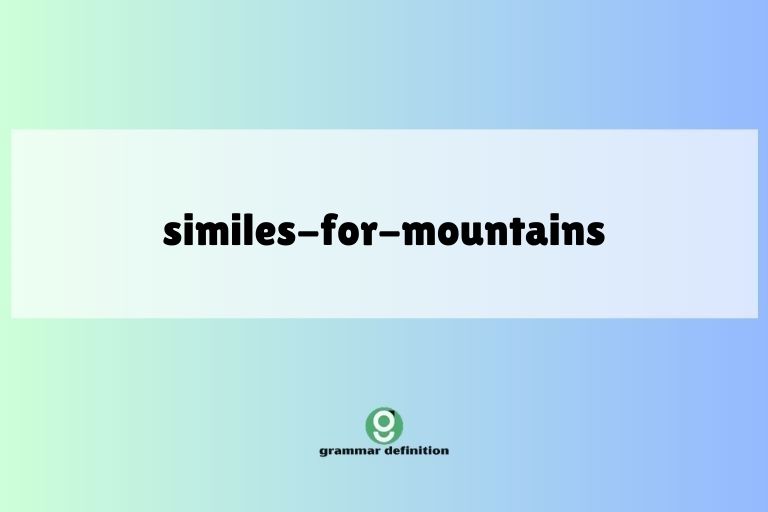Similes for Mountains: A Comprehensive Guide

Understanding similes is crucial for enhancing descriptive writing and comprehension. Similes, comparisons using “like” or “as,” add depth and vividness to language.
This article explores similes specifically related to mountains, enriching your vocabulary and writing skills. Whether you’re a student, writer, or language enthusiast, this guide provides a thorough understanding of mountain-related similes.
Table of Contents
- Introduction
- Definition of Simile
- Structural Breakdown of Mountain Similes
- Types of Mountain Similes
- Examples of Mountain Similes
- Usage Rules for Mountain Similes
- Common Mistakes with Mountain Similes
- Practice Exercises
- Advanced Topics in Mountain Similes
- Frequently Asked Questions
- Conclusion
Definition of Simile
A simile is a figure of speech that directly compares two different things using the words “like” or “as.” Similes are used to make descriptions more vivid and relatable by associating an unfamiliar concept with a familiar one. The purpose of a simile is to illuminate a quality or characteristic shared by the two compared items, adding depth and color to writing.
In essence, a simile says that something *is* *like* something else.
Similes differ from metaphors, which state that something *is* something else without using “like” or “as.” While both are figures of speech used for comparison, similes are more explicit and direct in their comparison. Understanding the nuance between similes and metaphors can greatly improve one’s writing and comprehension skills.
Structural Breakdown of Mountain Similes
The basic structure of a mountain simile involves comparing a mountain to another object, concept, or person using “like” or “as.” The structure typically follows this pattern: Subject (Mountain) + Verb + “Like” or “As” + Object of Comparison. For instance, “The mountain stood like a sentinel” or “The mountain range was as imposing as a fortress.”
The key elements of a mountain simile are the mountain itself (the subject), the comparative word (“like” or “as”), and the object of comparison (the element that shares a characteristic with the mountain). The effectiveness of the simile hinges on the clarity and relevance of the comparison.
A well-crafted simile highlights a specific attribute of the mountain, such as its size, strength, or appearance.
For example, consider the simile “The mountain was as tall as a skyscraper.” Here, the mountain’s height is being compared to the height of a skyscraper, emphasizing its immense size. The choice of the object of comparison (skyscraper) is crucial in conveying the intended image.
Similarly, in “The mountain stood like a silent guardian,” the mountain’s steadfastness and protective nature are being compared to a guardian.
Types of Mountain Similes
Mountain similes can be categorized based on the specific attributes they emphasize. Here are some common types:
Similes Describing Size and Height
These similes focus on the immense size and towering height of mountains. They often use comparisons to other large structures or natural formations to convey the scale of the mountain.
Similes Describing Strength and Stability
These similes highlight the unyielding strength and stability of mountains. They often compare mountains to strong, immovable objects or concepts, emphasizing their resilience.
Similes Describing Appearance and Beauty
These similes focus on the visual appeal and aesthetic qualities of mountains. They often use comparisons to beautiful landscapes, objects, or works of art to convey the mountain’s beauty.
Similes Describing Challenges and Difficulty
These similes emphasize the challenges and difficulties associated with climbing or traversing mountains. They often use comparisons to arduous tasks or obstacles to convey the demanding nature of mountains.
Similes Describing Age and Endurance
These similes highlight the age and enduring nature of mountains. They often use comparisons to ancient objects or timeless concepts to convey the mountain’s long history and resilience over time.
Examples of Mountain Similes
Here are numerous examples of mountain similes, categorized by the attribute they emphasize.
Size and Height Examples
The following table provides examples of similes that describe the size and height of mountains.
| Simile | Explanation |
|---|---|
| The mountain was as tall as a skyscraper. | Emphasizes the mountain’s great height by comparing it to a very tall building. |
| The mountain loomed like a giant. | Highlights the mountain’s imposing size, suggesting it is very large and dominant. |
| It rose like a colossal wave frozen in time. | Compares the mountain’s form and size to a massive wave, emphasizing its frozen, static nature. |
| The peak soared as high as an eagle’s flight. | Indicates the extreme altitude of the mountain’s peak. |
| The range stretched like a spine across the land. | Illustrates the length and prominence of the mountain range. |
| It stood like a titan guarding the valley. | Emphasizes the mountain’s immense size and protective presence. |
| The mountain seemed as endless as the sky above. | Highlights the perceived limitlessness of the mountain’s height. |
| It ascended like a staircase to the heavens. | Suggests a steep, continuous climb to great heights. |
| The mountain towered as high as a cumulonimbus cloud. | Compares the mountain’s height to a very tall, towering cloud. |
| The mountain was as massive as a pyramid. | Highlights the mountain’s substantial size and solid structure. |
| The mountain seemed as big as a small country. | Exaggerates the mountain’s size, suggesting it is incredibly large. |
| It stood tall like a sentinel on the horizon. | Emphasizes the mountain’s height and its role as a landmark. |
| The peak reached up like a finger pointing to the sky. | Illustrates the mountain’s sharp, upward-pointing peak. |
| It rose abruptly like a wall from the plain. | Highlights the steepness and sudden rise of the mountain. |
| The mountain was as high as a stack of ten Empire State Buildings. | Emphasizes the mountain’s enormous height using a well-known landmark. |
| The mountain was like a sleeping giant, vast and still. | Compares the mountain’s massive size and stillness to a giant at rest. |
| It stood as high as hope, reaching for the clouds. | Connects the mountain’s height to an aspirational feeling. |
| The mountain rose like a silent, stony wave. | Compares its form to a wave, but emphasizes its stillness and composition. |
| The peak was as high as the ambition of kings. | Relates the height to the lofty aspirations of powerful figures. |
| It towered like a monument to the sky. | Highlights the mountain’s impressive height and grandeur. |
| The mountain stood as tall as legends told. | Implies a height that is both impressive and part of enduring stories. |
| It rose above the world like a challenge to the heavens. | Suggests the mountain’s height is almost defiant and imposing. |
| The mountain was as immense as the dreams of mankind. | Connects the mountain’s size to the boundless potential of human aspirations. |
| It stood like a high-rise made of stone and earth. | Compares the mountain to a modern, tall structure. |
Strength and Stability Examples
The following table provides examples of similes that describe the strength and stability of mountains.
| Simile | Explanation |
|---|---|
| The mountain stood like a fortress. | Emphasizes the mountain’s strength and impregnability. |
| It was as solid as a rock. | Highlights the mountain’s stability and firmness. |
| The mountain stood firm like an ancient oak. | Compares the mountain’s resilience to a long-lived, sturdy tree. |
| It was as unyielding as a stubborn mule. | Highlights the mountain’s resistance to change or movement. |
| The mountain remained steadfast like a silent guardian. | Emphasizes its protective and unwavering presence. |
| It stood strong like a bulwark against the storm. | Compares the mountain’s protective role to a defensive structure. |
| The mountain was as immovable as time itself. | Highlights the mountain’s enduring and unchanging nature. |
| It was like a stone giant, unshakeable and strong. | Emphasizes the mountain’s immense strength and stability. |
| The mountain stood like a sentinel, unmoving through the ages. | Compares the mountain’s steadfastness to a watchful guard. |
| It was as sturdy as the foundations of the earth. | Highlights the mountain’s deep-rooted stability. |
| The mountain stood like a monument, impervious to change. | Emphasizes its resistance to alteration over time. |
| It was as resilient as the ancient bedrock beneath. | Compares the mountain’s durability to the underlying rock. |
| The mountain stood like a silent, watchful protector of the valley. | Highlights its protective role and quiet strength. |
| It was as enduring as the legends told about it. | Compares the mountain’s longevity to the enduring stories. |
| The mountain stood like a bastion against the ravages of time. | Emphasizes its role as a defense against decay. |
| It was as solid as the will of the earth itself. | Connects the mountain’s strength to the power of the earth. |
| The mountain stood like an anchor, holding the land together. | Highlights its role in providing stability to the surrounding area. |
| It was as firm as the resolve of a determined climber. | Compares the mountain’s strength to human determination. |
| The mountain stood like a silent promise of permanence. | Emphasizes its enduring presence and stability. |
| It was as unyielding as the force of gravity. | Compares the mountain’s steadfastness to a fundamental force of nature. |
| The mountain remained as steadfast as the North Star in the night sky. | Highlights its unwavering presence and reliability. |
| It stood like a bulwark, defying the winds and the weather. | Emphasizes its resistance to harsh environmental conditions. |
| The mountain was as unwavering as the course of a river. | Compares its steadfastness to the persistent flow of a river. |
| It stood like a fortress of stone, guarding the secrets within. | Highlights its protective nature and the mysteries it holds. |
Appearance and Beauty Examples
The following table provides examples of similes that describe the appearance and beauty of mountains.
| Simile | Explanation |
|---|---|
| The mountain glistened like a jewel in the sun. | Emphasizes the mountain’s sparkling beauty. |
| It was as majestic as a king on his throne. | Highlights the mountain’s regal and imposing appearance. |
| The mountain shone like a beacon in the distance. | Compares the mountain’s visibility and attractiveness to a guiding light. |
| It was as picturesque as a postcard scene. | Highlights the mountain’s visual appeal and scenic beauty. |
| The mountain looked like a painting, crafted by nature’s hand. | Emphasizes the mountain’s artistic and natural beauty. |
| It was as stunning as a sunset over the ocean. | Compares the mountain’s beauty to a breathtaking natural phenomenon. |
| The mountain resembled a sleeping goddess, serene and beautiful. | Highlights the mountain’s peaceful and graceful appearance. |
| It was like a cathedral of stone, awe-inspiring and grand. | Emphasizes the mountain’s magnificent and spiritual presence. |
| The mountain looked as pristine as a freshly fallen snow. | Compares the mountain’s purity and untouched beauty to new snow. |
| It was as enchanting as a fairytale castle. | Highlights the mountain’s magical and captivating appearance. |
| The mountain stood like a silent symphony in stone. | Emphasizes its harmonious and artistic presence. |
| It was as vibrant as an artist’s palette in autumn. | Compares the mountain’s colorful beauty to a painter’s array of colors. |
| The mountain looked like a natural sculpture, carved by wind and time. | Highlights its artistic form shaped by natural forces. |
| It was as ethereal as a dream on the horizon. | Compares the mountain’s distant and dreamlike appearance. |
| The mountain shone like a diamond against the velvet sky. | Emphasizes its sparkling beauty against a dark background. |
| It was as flawless as a perfectly cut gemstone. | Compares the mountain’s beauty to the perfection of a jewel. |
| The mountain resembled a giant, ancient pyramid kissed by the clouds. | Highlights its impressive shape and interaction with the sky. |
| It was as graceful as a dancer, reaching for the heavens. | Compares the mountain’s elegant form to a dancer’s movements. |
| The mountain looked like a masterpiece, painted across the sky. | Emphasizes its artistic and beautiful presence in the landscape. |
| The mountain was as beautiful as a bride on her wedding day. | Highlights its radiant and special appearance. |
| It was like a natural monument, sculpted by the ages. | Emphasizes its timeless and artistic form. |
| The mountain stood as majestic as a lion surveying its kingdom. | Compares its imposing beauty to a regal animal. |
| It was as serene as a sleeping child, peaceful and undisturbed. | Highlights its tranquil and undisturbed beauty. |
| The mountain looked like a gateway to another world, mysterious and inviting. | Emphasizes its enchanting and otherworldly appearance. |
Challenges and Difficulty Examples
The following table provides examples of similes that describe the challenges and difficulties associated with mountains.
| Simile | Explanation |
|---|---|
| Climbing the mountain was like scaling a vertical wall. | Emphasizes the steepness and difficulty of the climb. |
| It was as challenging as solving a complex puzzle. | Highlights the mental and physical demands of climbing. |
| The ascent felt like fighting against a relentless current. | Compares the effort to overcoming a strong, opposing force. |
| It was as arduous as running a marathon uphill. | Highlights the physical endurance required for the climb. |
| Climbing the mountain was like navigating a labyrinth of stone. | Emphasizes the complex and confusing nature of the terrain. |
| It was as demanding as battling the elements in a storm. | Compares the struggle to facing harsh weather conditions. |
| The challenge of the mountain felt like an endless test of will. | Highlights the mental fortitude required to overcome the difficulty. |
| It was like climbing a staircase to the sky, one step at a time. | Emphasizes the slow and gradual progress of the climb. |
| The mountain’s challenge was as daunting as facing one’s greatest fear. | Compares the difficulty to confronting a significant personal challenge. |
| It was as unforgiving as a desert without water. | Highlights the harshness and lack of respite during the climb. |
| Climbing the mountain felt like battling gravity itself. | Emphasizes the constant struggle against the force of gravity. |
| It was as relentless as a ticking clock, pushing you forward. | Compares the pressure to keep going to the constant passage of time. |
| The challenge of the mountain felt like an uphill battle against fate. | Highlights the sense of struggling against an overwhelming force. |
| It was as isolating as being stranded on a desert island. | Compares the feeling of being alone and isolated during the climb. |
| Climbing the mountain was like walking on the edge of a knife. | Emphasizes the precarious and dangerous nature of the climb. |
| It was as exhausting as running on a treadmill for hours. | Highlights the physical strain and fatigue of the climb. |
| The challenge of the mountain felt like an unending quest. | Compares the climb to a long and arduous journey. |
| It was as testing as enduring a long, cold winter. | Highlights the endurance and resilience required for the climb. |
| Climbing the mountain was like solving a riddle with no answer. | Emphasizes the mental challenge and uncertainty of the climb. |
| It was as demanding as carrying the weight of the world on your shoulders. | Compares the burden of the climb to a heavy emotional weight. |
| The climb was like a trial by fire, testing your limits. | Highlights the intense and transformative nature of the challenge. |
| It was as strenuous as pushing a boulder uphill. | Emphasizes the immense effort required for each step. |
| The mountain’s ascent felt like an eternal staircase to nowhere. | Highlights the seemingly endless and daunting nature of the climb. |
| It was as challenging as navigating a maze in the dark. | Compares the difficulty to a confusing and disorienting experience. |
Age and Endurance Examples
The following table provides examples of similes that describe the age and endurance of mountains.
| Simile | Explanation |
|---|---|
| The mountain stood like an ancient sentinel, watching over the land for centuries. | Emphasizes the mountain’s long history and enduring presence. |
| It was as old as time itself, weathered by countless seasons. | Highlights the mountain’s immense age and resilience. |
| The mountain stood like a silent witness to history, unchanged by the passage of time. | Compares the mountain’s enduring presence to a historical observer. |
| It was as timeless as the stars in the night sky, a constant presence. | Highlights the mountain’s unchanging nature over vast periods. |
| The mountain resembled an ancient giant, sleeping peacefully for millennia. | Emphasizes the mountain’s long existence and tranquil presence. |
| It was like a stone monument, erected by the hands of time itself. | Compares the mountain to a lasting tribute created by the ages. |
| The mountain stood like a weathered sage, wise and enduring. | Highlights the mountain’s age and the sense of wisdom it embodies. |
| It was as resilient as the earth itself, unyielding to the forces of nature. | Compares the mountain’s durability to the strength of the earth. |
| The mountain stood like a timeless guardian, protecting the secrets of the past. | Emphasizes the mountain’s enduring role as a protector of history. |
| It was as enduring as the legends told about it, passed down through generations. | Highlights the mountain’s longevity and its connection to enduring stories. |
| The mountain resembled an ancient fortress, scarred by the battles of time. | Emphasizes the mountain’s age and the marks of history it bears. |
| It was like a silent book, filled with the stories of the ages. | Compares the mountain to a repository of historical knowledge. |
| The mountain stood like a weathered statue, sculpted by the winds of time. | Highlights the mountain’s artistic form shaped by the passage of time. |
| It was as constant as the rhythm of the seasons, a reliable presence. | Compares the mountain’s enduring nature to the predictable cycle of seasons. |
| The mountain resembled a wise old soul, bearing the weight of centuries. | Emphasizes the mountain’s age and the sense of wisdom it embodies. |
| It was like a natural archive, preserving the memories of the earth. | Compares the mountain to a storehouse of geological history. |
| The mountain stood like an ancient tree, its roots deep in the past. | Highlights the mountain’s deep-rooted history and enduring presence. |
| It was as unshakeable as the foundations of the world, a permanent fixture. | Compares the mountain’s stability to the fundamental elements of the earth. |
| The mountain resembled a silent philosopher, contemplating the mysteries of the universe. | Emphasizes the mountain’s enduring presence and reflective nature. |
| The mountain stood like a testament to time, enduring through ages. | Highlights its role as a lasting symbol of history. |
| It was as ageless as the echoes of ancient civilizations. | Compares its timelessness to the remnants of past societies. |
| The mountain resembled a weathered map, etched with the stories of the earth. | Emphasizes its role as a record of geological events. |
| It was like a living fossil, connecting us to the distant past. | Compares it to a preserved relic of ancient times. |
| The mountain stood as a symbol of endurance, defying erosion and decay. | Highlights its resistance to the forces of nature over time. |
Usage Rules for Mountain Similes
When using mountain similes, it’s important to ensure that the comparison is both clear and relevant. The object of comparison should share a recognizable characteristic with the mountain, and the simile should enhance the description rather than confuse it.
Avoid clichés and strive for originality in your comparisons.
Consider the context in which the simile is being used. A simile that is appropriate for a formal essay might not be suitable for a casual conversation.
Pay attention to the tone and audience when choosing your similes. A well-chosen simile can add depth and nuance to your writing, while a poorly chosen one can detract from it.
Furthermore, ensure grammatical correctness. The words “like” and “as” should be used correctly to form the simile.
For example, “The mountain was as tall *as* a skyscraper” is correct, while “The mountain was tall *like* a skyscraper” is less formal and potentially less effective depending on the context.
Common Mistakes with Mountain Similes
One common mistake is using similes that are too generic or cliché. For example, saying “The mountain was as big as a house” is not particularly descriptive or evocative.
Instead, opt for more specific and imaginative comparisons. Another mistake is using similes that don’t make sense or are not logically sound.
For instance, “The mountain was as fast as a car” is nonsensical because mountains are not typically associated with speed.
Another frequent error is mixing metaphors and similes. While both are figures of speech, they function differently.
A simile uses “like” or “as” for comparison, whereas a metaphor directly equates two things. Mixing the two can lead to confusing and ineffective writing.
For example, instead of saying “The mountain was a fortress, like a sentinel,” choose either “The mountain was a fortress” (metaphor) or “The mountain stood like a sentinel” (simile).
Here are some examples of common mistakes and corrections:
| Incorrect | Correct | Explanation |
|---|---|---|
| The mountain was big like anything. | The mountain was as big as a skyscraper. | The original is vague; the correction provides a specific comparison. |
| The mountain was strong as a flower. | The mountain was as strong as a fortress. | The original comparison is illogical; the correction uses a more appropriate object. |
| The mountain is a fortress, as strong like a wall. | The mountain is a fortress. (metaphor) OR The mountain is as strong as a wall. (simile) | The original mixes a metaphor and a simile; the corrections separate them. |
| The mountain was beautiful like good. | The mountain was as beautiful as a painting. | The original is abstract; the correction provides a concrete comparison. |
| The mountain was tall as running. | The mountain was as tall as a skyscraper. | The original comparison doesn’t make sense; the correction provides a logical comparison. |
Practice Exercises
Test your understanding of mountain similes with these practice exercises.
Exercise 1: Complete the Simile
Complete the following similes with an appropriate comparison using “like” or “as.”
| Question | Answer |
|---|---|
| 1. The mountain stood tall, __________. | 1. The mountain stood tall, like a silent guardian. |
| 2. The peak was as high __________. | 2. The peak was as high as an eagle’s nest. |
| 3. Climbing the mountain was like __________. | 3. Climbing the mountain was like scaling a vertical wall. |
| 4. The mountain’s beauty shone __________. | 4. The mountain’s beauty shone like a jewel in the sun. |
| 5. It was as strong __________. | 5. It was as strong as a fortress. |
| 6. The mountain range stretched __________. | 6. The mountain range stretched like a sleeping dragon. |
| 7. The mountain looked __________. | 7. The mountain looked like a painting crafted by nature. |
| 8. The ascent felt __________. | 8. The ascent felt as challenging as solving a complex puzzle. |
| 9. The mountain stood __________. | 9. The mountain stood as timeless as the stars above. |
| 10. It was as enduring __________. | 10. It was as enduring as the legends told about it. |
Exercise 2: Identify the Type of Simile
Identify the type of simile used in each sentence (Size/Height, Strength/Stability, Appearance/Beauty, Challenges/Difficulty, Age/Endurance).
| Question | Answer |
|---|---|
| 1. The mountain was as tall as a skyscraper. | 1. Size/Height |
| 2. It was as strong as a fortress. | 2. Strength/Stability |
| 3. The mountain glistened like a jewel. | 3. Appearance/Beauty |
| 4. Climbing it was like scaling a vertical wall. | 4. Challenges/Difficulty |
| 5. The mountain stood like an ancient sentinel. | 5. Age/Endurance |
| 6. It loomed like a giant. | 6. Size/Height |
| 7. The mountain stood firm like an ancient oak. | 7. Strength/Stability |
| 8. It was as majestic as a king on his throne. | 8. Appearance/Beauty |
| 9. The ascent felt like fighting a relentless current. | 9. Challenges/Difficulty |
| 10. It was as old as time itself. | 10. Age/Endurance |
Exercise 3: Correct the Incorrect Similes
Correct the following similes to make them more logical and descriptive.
| Question | Answer |
|---|---|
| 1. The mountain was big like a small thing. | 1. The mountain was as big as a small town. |
| 2. It was strong like a feather. | 2. It was as strong as a steel beam. |
| 3. The mountain was beautiful like ugly. | 3. The mountain was as beautiful as a painting. |
| 4. Climbing it was like flying. | 4. Climbing it was like battling gravity. |
| 5. The mountain was old like yesterday. | 5. The mountain was as old as the earth itself. |
| 6. It was tall like short. | 6. It was as tall as the clouds. |
| 7. The mountain stood firm like water. | 7. The mountain stood firm like a rock. |
| 8. It was as majestic as a pebble. | 8. It was as majestic as a king on his throne. |
| 9. The ascent felt like relaxing. | 9. The ascent felt like a constant battle. |
| 10. It was as enduring as a fleeting moment. | 10. It was as enduring as the ages. |
Advanced Topics in Mountain Similes
For advanced learners, exploring the cultural and historical context of mountain similes can provide deeper insights. Different cultures may have unique ways of describing mountains based on their geographical location and beliefs.
For example, in some cultures, mountains are revered
as sacred sites, and their descriptions often reflect this reverence.
Studying mountain similes in literature can also enhance your understanding of their use and impact. Authors often use similes to evoke specific emotions or set a particular tone.
Analyzing these literary examples can provide valuable insights into the art of descriptive writing.
Additionally, exploring the etymology of words related to mountains can enrich your vocabulary and understanding of mountain-related concepts. Understanding the origins of words like “summit,” “peak,” and “range” can add depth to your writing and comprehension.
Frequently Asked Questions
What is the difference between a simile and a metaphor?
A simile is a comparison using “like” or “as,” while a metaphor directly equates two things without using those words. For example, “The mountain is like a fortress” (simile) versus “The mountain is a fortress” (metaphor).
How can I avoid using cliché similes?
Strive for originality by thinking of unique and specific comparisons. Instead of saying “The mountain was as big as a house,” try “The mountain was as big as a small town.”
Why are similes important in writing?
Similes add depth, vividness, and relatability to writing by making descriptions more engaging and understandable. They help readers visualize and connect with the subject matter.
Can a simile be too complex?
Yes, if the comparison is too obscure or difficult to understand, it can confuse the reader. Aim for clarity and relevance in your similes.
How do I choose the right simile for a mountain description?
Consider the specific attribute you want to emphasize (size, strength, beauty, etc.) and choose an object of comparison that clearly reflects that attribute. Also, think about the tone and audience of your writing.
Conclusion
Mastering the art of mountain similes can significantly enhance your descriptive writing and appreciation of language. By understanding the structure, types, and usage rules of mountain similes, you can create vivid and engaging descriptions that capture the essence of these majestic landforms.
Whether you’re a student, writer, or language enthusiast, the knowledge and exercises provided in this guide will empower you to use mountain similes effectively and creatively.






